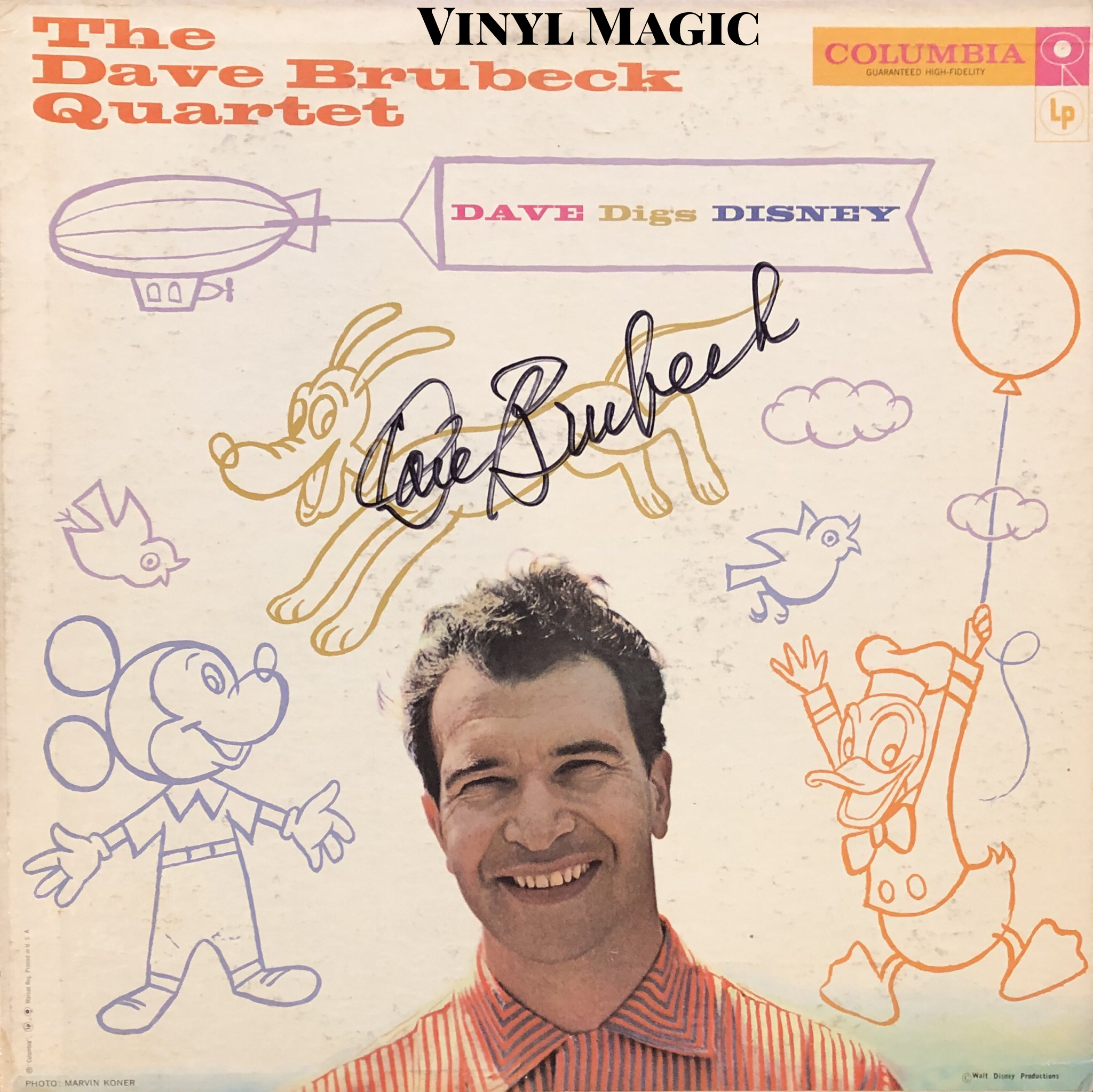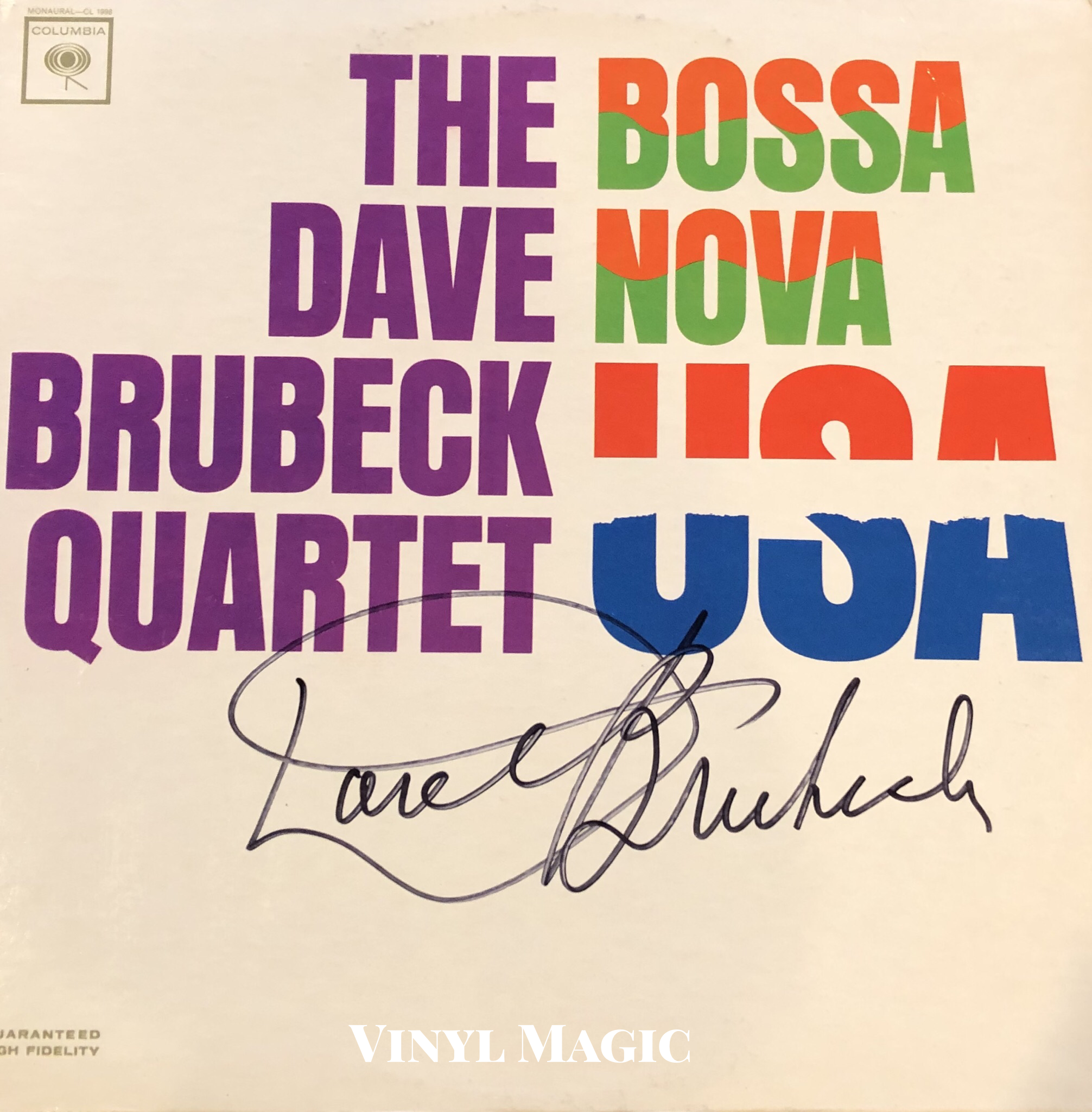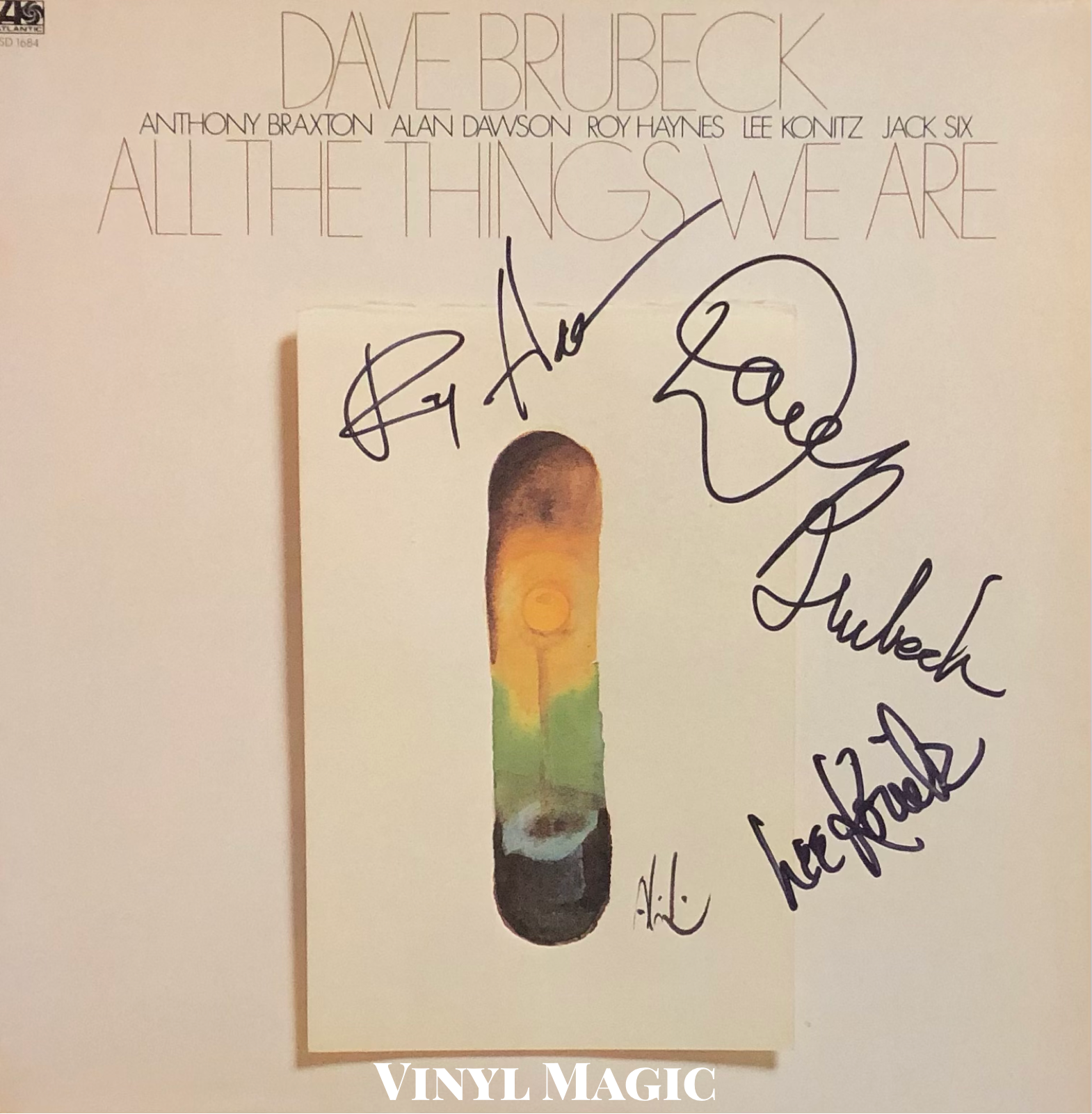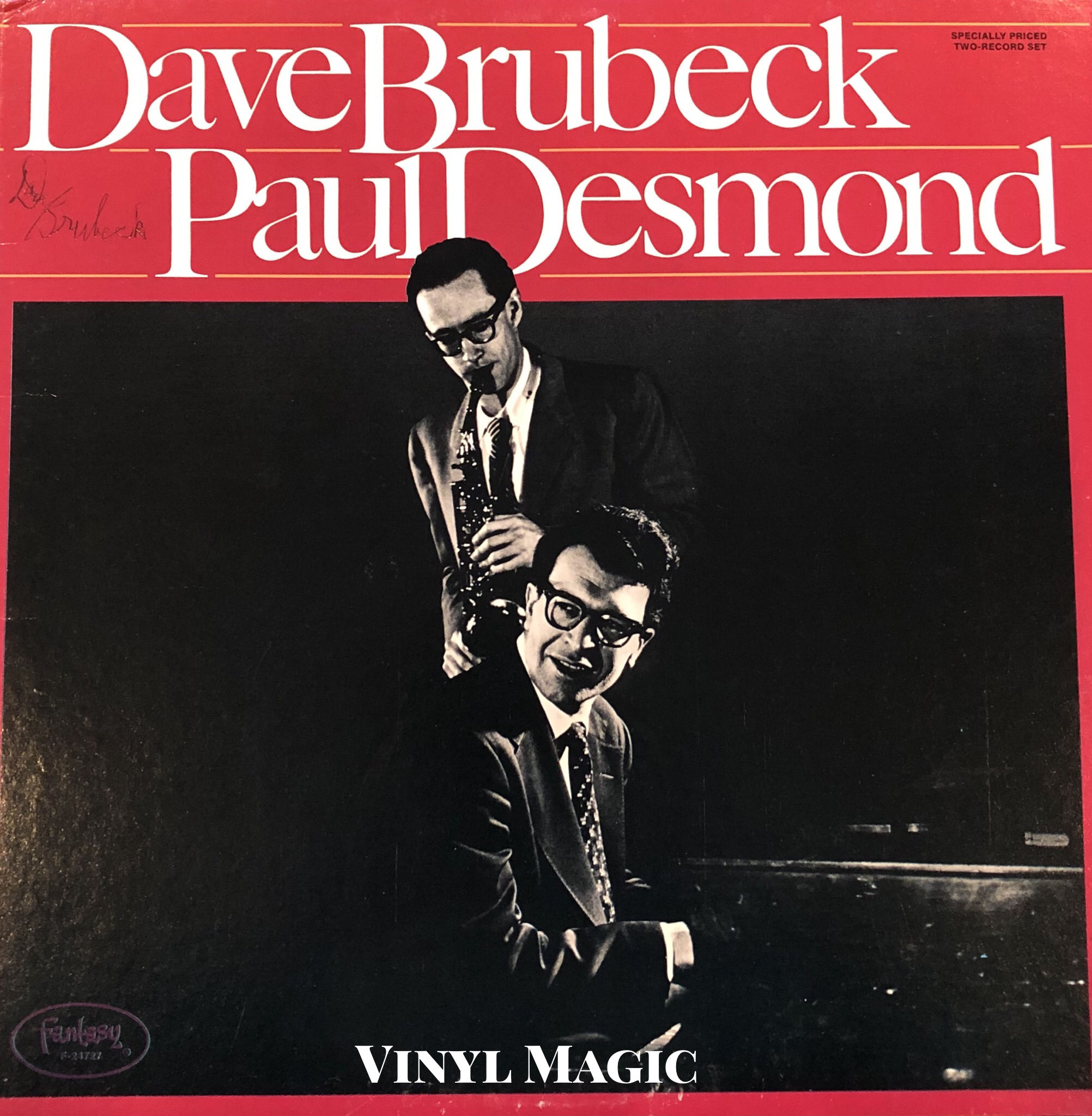Dave Brubeck, Richard Avedon and Me…
There's a way of playing safe, there's a way of using tricks and there's the way I like to play which is dangerously, where you're going to take a chance on making mistakes in order to create something you haven't created before.
Dave Brubeck
The Dave Brubeck Trio (1950 10”) signed by Dave
The first recording I bought cost 48¢. It was an acetate recording. I went to Sacramento with the idea of buying that record. At that time, I was working all day for a dollar, so to spend I think, with tax, 50¢, was half-a-day’s work. So it was a big event. I bought Fats Waller’s “Let’s Be Fair and Square In Love” and “There’s Honey On the Moon Tonight.”
Dave Brubeck, early cratedigging
Dave Brubeck Trio (1960) signed by Dave
Duke Ellington, Art Tatum, and many other great jazz musicians objected to their music being called jazz. While the outside world may want to put a label on it, those who create it think of it just as music, and tend not to classify it. The reality for me is simple. When music is written, it is usually categorized as classical. When it is improvised, it can still be called classical if it is an inspired improvisation. In either category, it is still music, and it can be good or bad or simply mediocre. In my own work, the improvised sections can sometimes reach an audience on a different emotional level because of the immediacy. A sensitive improviser reflects the feeling and atmosphere of a particular moment in place and time, as well as connecting with the musical material in the composed sections.
Dave Brubeck
Brubeck Plays Brubeck (1956) signed by Dave
Absolutely. I couldn’t read music while I was there… I felt that I was hiding all the time. When the dean of the school (College of the Pacific) wouldn’t let me graduate, the two best teachers came to my rescue. The counterpoint teacher said to the dean, “You’re making a mistake. He’s written the best counterpoint I ever heard from a student.” My harmony and ear training teacher said, “Dave is way advanced harmonically.” The dean called me into his office and said, “I'll let you graduate with the class if you promise never to teach.” I kept that promise ever since, even when I was starving.
Dave Brubeck
Dave Digs Disney (1957) signed by Dave
I’ve always liked all my groups. But when one of my favorite drummers, Joe Dodge, left the group, Paul told me about Joe Morello. So we went over to the Hickory House and listened to Joe, and he didn’t play anything but with the brushes all night. Paul said, “oh, that would be so wonderful; I could really love playing with him.” So I told Joe, “I’d like you to join my group.” Because Marian was going back to England for a while, and he wouldn’t have a job, so it kind of worked. So he said, “Look, you’ve always kept your drummer kind of in the background. I wouldn’t go for that. If I’m going to play with you, I want to develop as a soloist, and I want to develop in some new directions.” So I said, “That would be great, Joe; I’d like to go in some new directions I’ve been thinking about.” Our first job was in Chicago. No time to rehearse. The first night Joe was on the stage, I gave him a drum solo, and he broke it up with the audience, more than anything that we had done all night. So when we got off stage, Paul said, “Either he goes or I go.” I said, “Paul, he’s not going.”
I don’t know what I’m thinking. I’m thinking Paul’s not serious—maybe. I had to wait til the next night to see if my bass player, who also sided in with Paul, didn’t like to have this star on drums. So I was going to play with just Joe and I. It was at the Blue Note in Chicago, too. You had to be pretty good, or you wouldn’t stay there. But they came just in time to play. So now I have two stars in the group. I wrote a tune called “Sounds of the Loop” that featured Joe on my next album…So my answer is go with what you have. With Joe, I could see a whole different way of going, and that would be the beginning of getting into things finally like “Time Out.”
Dave Brubeck on his great drummer Joe Morello
Newport 1958 (1958) signed by Dave, Joe Morello
Jazz stands for freedom. It's supposed to be the voice of freedom. Get out there and improvise, and take chances and don't be a perfectionist - leave that to the classical musicians.
Dave Brubeck
Jazz Impressions Of The U.S.A. (1957) signed by Dave, Joe Morello
In Europe (1958) signed by Dave, Joe Morello
I think it's equally as important as ”Take Five,” but Columbia wanted to push ”Take Five.” Blue Rondo a la Turk” is based on a street rhythm I heard while we were in Turkey. It's in 9/8 time, with the blues section in 4/4. People loved that song and still do. “Take Five” is a title you could put on a jukebox and remember more easily in a record store. ”Blue Rondo a la Turk”” was too long a song title. In those days, the jukebox determined what became a hit. I should have called it just “Blue Rondo.” “Blue Rondo a la Turk” wound up as the B side of the single.
Dave Brubeck
Dave Brubeck Octet (1950) signed by Dave
When I first heard Joe play that beat backstage and Paul improvised against it, I said to Paul at our rehearsal for Time Out, “Try to write down some of your improvisations.” When he came back to the rehearsal, he said, “I can’t write anything in 5/4.” I said, “Well, I just heard you improvising on it and you sounded great.” Paul said, “I wrote down some of those things.” I said, “Great, let me see what you have.” I looked at what Paul had done and said, “Paul, I can put this together, and it will be a great tune.” We gave it a try, and the approach worked. The title is mine and so were the lyrics: “Won't you stop and take a little time out with me, just take five. Stop your busy day and take the time out, to see, I'm alive." Teo Macero, the album’s producer, said there had to be a cover of the song with words to it. That was Columbia's way of covering its bases with the tricky 5/4 time, to have a vocal version. When I told that to Paul, he said he wanted his father to write them. But they didn’t come in as soon as we needed them. Teo wanted words so Carmen McRae could sing the cover almost immediately.
Dave Brubeck on the origin of “Take Five”
Brubeck a la mode (1960) signed by Dave, Joe Morello
The word “osmosis” is the only way I seem to learn. Just listening and being. I learned so much from (composer Darius) Milhaud about life. He wasn’t trying to teach me about life. I was with him a lot. And I learned so much from Ellington. We were on the road together, and in some kind of situation where we were not being treated fairly. I started describing what I thought this person was doing to us, and he said, “Dave, you’re right, but let’s not get any of his bad shit in our blood.” One time I was with him on a radio show, and the announcer-emcee asked what we thought of rock-and-roll. I started to talk about what I thought about it, and I could see that Duke didn’t like what I was saying, so I cut it very short, thank goodness. He said, “Well, Mister Ellington, what do you think?” He said, “If the American public likes it, it must be good.” I thought, “Boy, this old man is so sharp; how to get out of a nasty… He knows without saying anything.” Osmosis, being around Duke, just helped me in life. He was such a wonderful man to me.
Dave Brubeck
Bossa Nova USA (1962) signed by Dave
Dave Brubeck is best known for his song "Take Five", the first jazz single to sell one million copies when it was released in 1959 - a nearly impossible feat for a jazz song then, and especially now. Though Dave was a prolific composer and wrote many jazz standards - "In Your Own Sweet Way", "The Duke", "Blue Rondo a la Turk" - "Take Five' was written by Paul Desmond, his longtime colleague and superlative alto saxophonist. The song derived its name from the unusual 5/4 time in which it was played. Interestingly, when Desmond died of lung cancer in 1977, he left all "Take Five" royalties to the American Red Cross, a nice stream of recurring revenues, I'm sure.
Time Out (1959) signed by Dave, Joe Morello
One night at the Blue Note in New York City, I was visiting with Dave after a concert and I asked him about the album cover shot by legendary photographer Richard Avedon for Jazz: Red Hot And Cool, released in 1955 on Columbia Records. I remarked that the model was wearing a beautiful red dress. He corrected me, "That was no dress. That was a piece of fabric that was draped (strategically) over her." While Dave looks and plays straight ahead, Paul Desmond's attention and focus is elsewhere.
Red Hot And Cool (1956) signed by Dave, Photo by Richard Avedon
Richard Avedon, a fashion and portrait photographer at Harper's Bizarre and Vogue for decades, also took portraits of Barbra Streisand, Simon & Garfunkel, Lena Horne, Sly & The Family Stone, and The Beatles for album covers. Avedon once said, "All photographs are accurate. None of them are the truth." He must not have been thinking about his Brubeck and Desmond photo on Jazz: Red Hot And Cool. It is a perfect metaphor for the two jazz men's disparate lives. Dave Brubeck, a teetotaler who never took drugs, was a devoted father and husband. Brubeck stares cheerily ahead, past the remonstrances of his comely, nearly undressed suitor. In contrast, Paul Desmond was a womanizer and a dissolute, drug abusing alcoholic who died from lung cancer. Not an unexpected outcome for a man who chain smoked and once said, "I think I had it in the back of my mind that I wanted to sound like a dry martini." Paul Desmond stares exactly where you think he would, and Richard Avedon captured the truth in that photo.
Most days, I try to live like Dave Brubeck, but, some days, I’d rather be Paul Desmond…
Bookends (1968) signed by Paul Simon, Art Garfunkel photo by Richard Avedon
Blues Roots (1969) signed by Dave
All The Things We Are (1973) signed by Dave, Lee Konitz, Roy Haynes
Southern Scene (1960) signed by Dave, Joe Morello
Jazz Impressions Of New York (1964) front cover, unsigned
Jazz Impressions Of New York back cover signed by Dave
Dave Brubeck Paul Desmond (1982 reissue, 1952 recordings) signed by Dave
Gone With The Wind (1959) signed by Dave
Instant Brubeck (1969 reissue, 1954 recordings) signed by Dave
Choice Dave Brubeck Cuts (per BKs request)
https://www.youtube.com/watch?v=tT9Eh8wNMkw
"Take Five" Brubeck and Desmond, live in Belgium 1964
https://www.youtube.com/watch?v=vcnSDOJoEbI
"La Paloma Azul (The Blue Dove)" exquisite Mexican folk tune rendered by Brubeck, Desmond in Antibes, France 1967
https://www.youtube.com/watch?v=KBFzLEMvi4M
"Someday My Prince Will Come" Dave Digs Disney 1957
https://www.youtube.com/watch?v=KYlO3H40V2o
"Somewhere Over The Rainbow" Brubeck reinvents with beautiful chords and time changes
https://www.youtube.com/watch?v=1DXWJWkeVww
"Angel Eyes" Dave Brubeck Quartet 1962
https://www.youtube.com/watch?v=j9GgmGLPbWU
"Blue Rondo A La Turk" Live, 1959





















